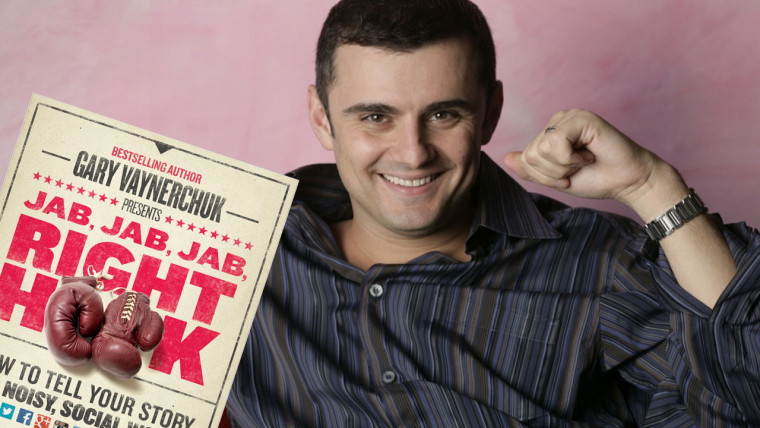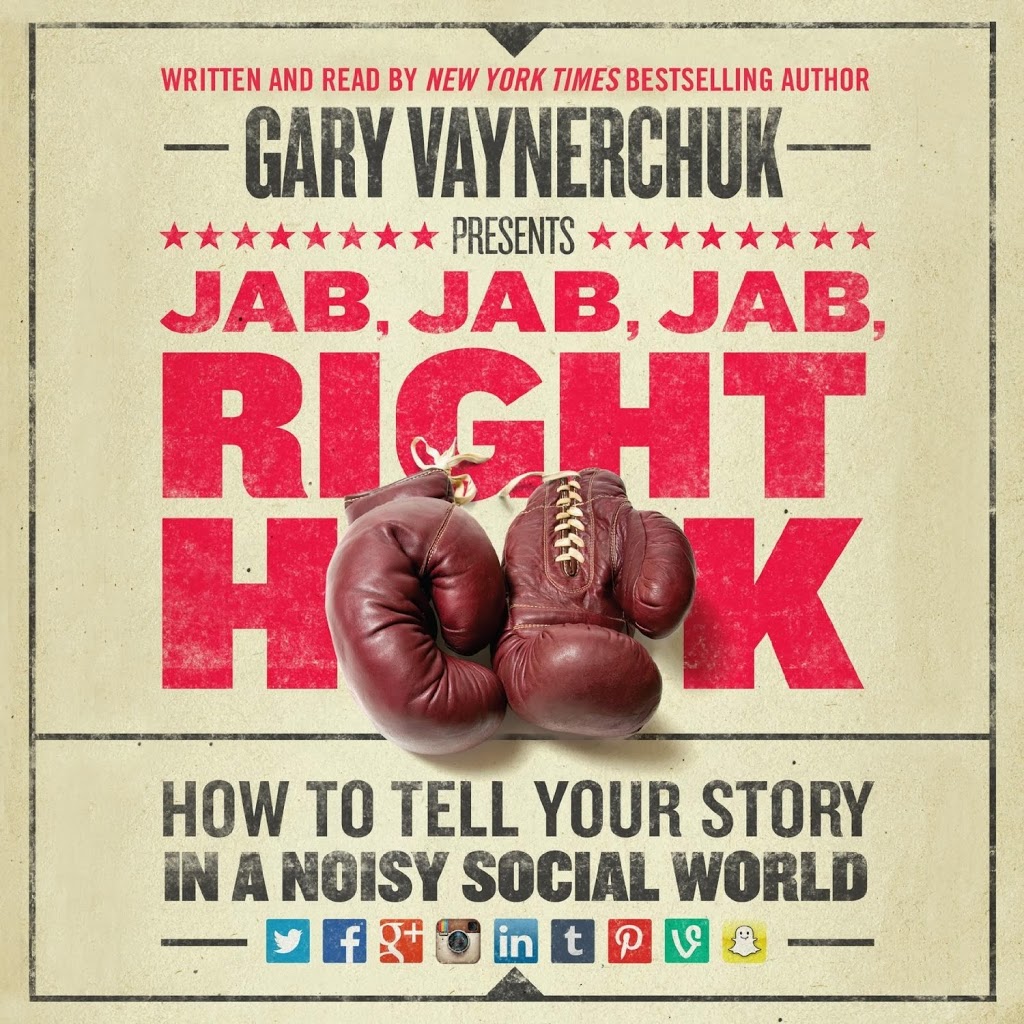Gary Vaynerchuk is a phenomenal storytelling entrepreneur. He is so good in what he does that Businessweek lauded him as “one of the top 20 people every entrepreneur should follow”.
Former founder of Wine Library and author of bestselling social media marketing books like Crush It! and The Thank You Economy, Gary’s straight talking shoot-from-the-hip style has won him many fans.
His latest book, memorably titled Jab, Jab, Jab, Right Hook (aka #JJJRH), certainly punches above its weight.
Lots of Social Media Jabbing Before the Hook
Deftly weaving in analogies and metaphors from the boxing ring, Jab, Jab, Jab, Right Hook wasted no time in delivering practical tips in social media marketing.
Focused on the unique qualities of social media platforms like Facebook, Twitter, Pinterest, Instagram and Tumblr, #JJJRH is a useful guide to social content in the digital age.
Equating storytelling with boxing, Gary advised us to only deliver our “right hooks” – an analogy for marketing actions which convert customer traffic to sales – after we have done lots of “jabbing”. A jab here is taken to mean creating compelling content which engages with our customers while building relationships.
In other words, give give give and then take.
Qualities of Great Social Media Content
What then are the qualities of impactful storytelling content? Gary broke it down into 6 key points in his book:
#1 It’s Native
Different platforms exhibit different behaviours. As addictive as crack, social networking sites lights up the dopamine pathways and pleasure centres of consumer’s brains.
To do the same, our content must “look the same, sound the same, and provide the same value and emotional benefits” which people are seeking. Thus, it has to behave almost like the same sort of content which our customers would consume from their friends or family members.
In Gary’s words, “Content is king, but context is God.”
#2 It Doesn’t Interrupt
Do you remember the concept of Permission Marketing?
Popularised by Seth Godin, the idea here is that good marketing should blend seamlessly into the consumer’s experience. It should be welcoming, entertaining and useful, rather than a pain in the a**.
#3 It Doesn’t Make Demands – Often
Quoting Leo Burnett, Gary advised us to “Make it simple. Make it memorable/ Make it inviting to look at. Make it fun to read.”
In Gary’s words, give, give, give, give, give… ask.
#4 It Leverages Pop Culture
By integrating our content into the stream, people can consume it along with all of their pop culture candy. This is especially important given how much attention deficit we are all facing in this digitally distracted world.
#5 It’s Micro
With the fragmenting of attention, tiny, unique nuggets of information, humour, commentary, or inspiration counts. These should be delivered and re-imagined every day or even every hour.
In short, micro content + community management = effective social media marketing.
#6 It’s Consistent and Self-Aware
By consistently answering the question “Who are we?”, we can keep our messages coherent and aligned to our brand. This ensures that we do not commit any major faux pas in the way we relay our social media content.
The main part of the book covered the most popular social media networks on the web. Let me cover each of these in turn.
To master the web’s largest social network, we should understand its algorithm (formerly called EdgeRank) and analytics (Page Insights). The more a user engages (likes, comments or shares) with a piece of our content, the more likely he or she will view it in the future.
As most consumers access Facebook through their smartphones, their News Feeds will be the only “battleground” which matters.
Facebook posts should be targeted at specific demographics. The more precise they are, the better.
Posts should also not be overly lengthy, have striking and high-quality photos (with logos), and include an appropriate call to action. We should also not hesitate to invest in sponsored stories to multiply our organic reach when we have a winning piece of content (read more about the Anatomy of a Winning Facebook Ad here).
Unlike the walled garden of Facebook, Twitter is a free-for-all. I like to imagine it to be an information freeway, with a continuous flow of content traffic which is never ending.
Here, contextually relevant and to the point copy, high quality images, trending topics (aka trend-jacking or newsjacking), and unique and memorable hashtags are key. We should also not refrain from spending on promoted tweets if necessary.
Appealing primarily to women – half of whom are mothers – Pinterest’s value lies in providing users with serendipity. It is the most visually stunning and appealing social network, beating even Instagram for it’s aesthetic qualities.
Pictures and photos pinned to our boards should be aspirational, include a hyperlink, and double up as an advertisement. Or we can “pin” an accompanying photo to an article featured in a top-flight magazine. Our boards should also have clever and creative titles.
Artsy, indie and appealing primarily to the young, Instagram is ruled by hashtags.
To be effective, photos need to have stories which appeal to the younger generation, be of a certain quality, and be perceived to be authentic rather than commercial. Frequency is also important, as Instagram followers can be very finicky and readily unfollow sluggish Instagram accounts.
Tumblr
Skewing largely to the young like Instagram, Tumblr is defined by Gary as “indie rock”.
Acting like an exhibition space for photographers, musicians and graphic designers, Tumblr’s key value lies in its ability to display cool animated GIF images. Marketers should also customise the themes of their Tumblr blog to be aligned to their brand.
A Social Media Marketing “Knock Out”
The figurative “knock out” punch of the book comes in the form of the numerous positive and negative examples of storytelling on the social web’s most popular social platforms. They include brands like Ben & Jerry’s, Zara, Selena Gomez, Lacoste, FIFA, UNICEF and a lot more.
Beautifully illustrated with full colour photos, Gary’s insights on these alone are probably worth the weight of the book in gold.
While the book also covered other social networks like LinkedIn, Google Plus Snap Chat and Vine, relatively scant coverage was provided of these newer platforms. It would have been awesome if Google Plus was given more pages, especially in light of its growing prominence as a contender for Facebook. Having said that, my guess was that Gary probably selected the platforms which he was more familiar with.
In summary, Jab, Jab, Jab, Right Hook is an indispensable guide to anybody tasked to create content and manage communities on today’s most active social networks. Highly recommended.

Gary V and his latest book (source of image)


2 Comments